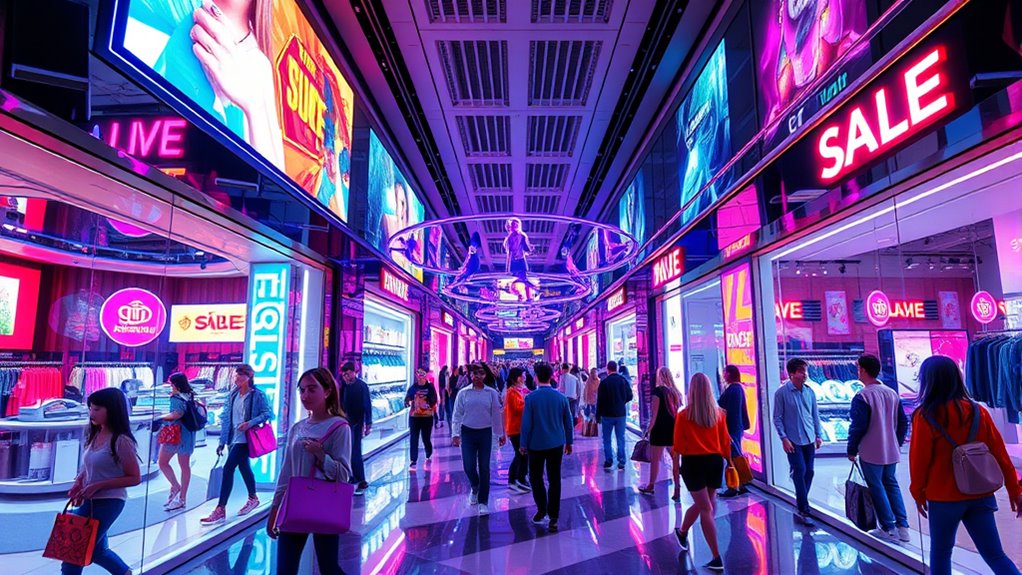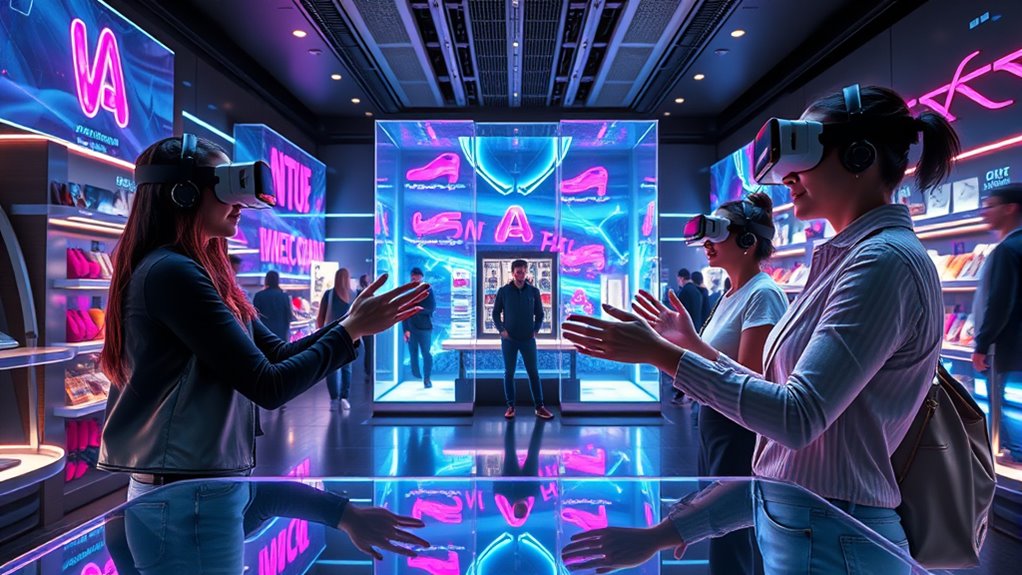The metaverse is becoming retail’s next frontier by offering immersive, interactive experiences that transform how you explore and shop. Virtual stores, try-ons, and showrooms let you test products from home, while AR and VR devices create realistic and engaging environments. Digital assets like NFTs add ownership and exclusivity, making shopping more personalized and fun. If you keep exploring, you’ll discover how this evolving space is reshaping your retail experience.
Key Takeaways
- The metaverse offers highly immersive virtual shopping environments with VR and AR, transforming retail experiences.
- Digital assets like NFTs enable ownership and trade of virtual goods, increasing engagement and brand loyalty.
- Rapid growth in XR devices and immersive technology enhances realism, making virtual stores more engaging.
- AI-powered virtual assistants personalize shopping, creating seamless and interactive customer journeys.
- Market projections indicate exponential growth, positioning the metaverse as the next frontier for retail innovation.

As the metaverse rapidly evolves, it’s becoming the next massive frontier for retail innovation. You’ll find that the market for metaverse retail is already valued at around USD 35 billion in 2024 and is projected to skyrocket to over USD 500 billion by 2032, growing at an impressive CAGR of about 45%. Even more compelling is the e-commerce segment within the metaverse, expected to grow from USD 48 billion this year to over USD 1.15 trillion by 2034, with a CAGR of roughly 37.4%. This rapid expansion is fueling a broader global metaverse retail market forecasted to reach USD 1,561.7 billion by 2034, at a staggering 47% CAGR from 2025 onwards. The overall metaverse market revenue is anticipated to surpass USD 2.3 trillion by 2032, reflecting recent explosive growth from USD 65 billion in 2022 to USD 203 billion in 2025. To support this expansion, XR headset shipments are expected to exceed 105 million by 2025, enabling more immersive and realistic retail experiences. VR and AR adoption rates are increasing rapidly worldwide, with AR device shipments projected to reach 1.73 billion units by 2024. You’ll notice that technological integration is at the core of this transformation. Virtual reality (VR) and augmented reality (AR) are creating immersive digital stores and showrooms where you can blend physical and online shopping seamlessly. This growth is driven by the increasing availability of AR-capable devices, projected to reach 1.73 billion users by 2024. AI-powered shopping assistants are making it easier to find personalized products and interact with brands in real time. Mixed reality features allow virtual try-ons, product testing, and virtual tours of retail spaces, giving you a richer and more engaging shopping journey. Blockchain and NFTs are enabling ownership and trade of digital goods, collectibles, and virtual assets, especially in fashion and art sectors, adding a new layer of value and exclusivity.
Frequently Asked Questions
How Will Physical Stores Coexist With Virtual Retail Spaces?
You’ll see physical stores and virtual retail spaces working together seamlessly. Physical locations will serve as experiential hubs with VR stations, interactive displays, and events that support virtual commerce. You can try products virtually before buying, attend hybrid events, or access exclusive digital assets. This integration enhances your shopping experience, offering convenience, personalization, and engagement across both channels, ultimately creating a unified retail environment that caters to your digital and physical preferences.
What Are the Main Challenges for Small Retailers Entering the Metaverse?
You face high financial barriers, as developing immersive virtual spaces demands significant investment in technology, talent, and infrastructure that small retailers often can’t afford. Technical complexity also poses challenges, requiring specialized skills for seamless integration and user-friendly interfaces. Plus, consumer adoption remains limited, with many customers lacking VR devices or trust in virtual environments. Regulatory uncertainties and security concerns further complicate your efforts to successfully enter and compete in the metaverse.
How Will Customer Data Privacy Be Protected in Metaverse Shopping?
Imagine your personal data as a fragile glass ornament—you need to handle it carefully. In metaverse shopping, privacy is protected through encryption, privacy-by-design, and transparent policies. You’ll see virtual notices and give explicit consent, just like signing a digital waiver. Implementing risk assessments and cybersecurity measures guarantees your data stays safe from hackers. Ultimately, retailers must prioritize your privacy to build trust and ensure a secure, immersive shopping experience.
What Hardware Is Necessary for Consumers to Access the Metaverse?
You’ll need a device like a smartphone, tablet, desktop, or laptop to access the metaverse. For better immersion, consider high-performance hardware like a powerful graphics card, a fast processor, at least 32 GB of RAM, and a reliable internet connection. For full immersion, VR headsets or AR glasses with haptic feedback are ideal. Upgrading your hardware guarantees smooth interactions and a more realistic virtual experience.
How Will Virtual Product Authenticity and Ownership Be Verified?
Think of verifying virtual product ownership like sealing a rare stamp in a tamper-proof album. You’ll use blockchain-based identities to cryptographically secure records, proving authenticity and ownership. Digital assets become like fingerprints, uniquely yours, and on-chain records act as unchangeable proof. This guarantees your virtual products are genuine, traceable, and securely yours across platforms, creating a trustworthy marketplace where your digital treasures are protected and recognized.
Conclusion
As you step into the metaverse, you’re entering a vibrant, endless marketplace where every click paints a new world. It’s like walking through a digital dreamscape, blending reality and imagination seamlessly. This immersive domain beckons you to explore, shop, and connect in ways never before imagined. Embrace this future, where retail becomes a living canvas, inviting you to lose yourself in a universe of endless possibilities, just waiting for you to make your mark.











